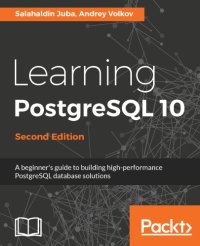
Ebook: Learning PostgreSQL 10
Author: Juba Salahaldin, Volkov Andrey
- Tags: Database management, SQL (Computer program language), Electronic books, PostgreSQL
- Year: 2017
- Publisher: Packt Publishing
- City: Birmingham
- Edition: 2nd edition
- Language: English
- epub
Cover -- Title Page -- Copyright -- Credits -- About the Authors -- About the Reviewers -- www.PacktPub.com -- Customer Feedback -- Table of Contents -- Preface -- Chapter 1: Relational Databases -- Database management systems -- A brief history -- Database categories -- The NoSQL databases -- The CAP theorem -- NoSQL motivation -- Key-value databases -- Columnar databases -- Document databases -- Graph databases -- Relational and object relational databases -- ACID properties -- The SQL language -- Relational model concepts -- Relation -- Tuple -- NULL value -- Attribute -- Constraint -- Domain integrity constraint -- Entity integrity constraint -- Referential integrity constraints -- Semantic constraints -- Relational algebra -- The select and project operations -- The rename operation -- The set theory operations -- The cartesian product operation -- Data modeling -- Data model perspectives -- The entity-relation model -- Sample application -- Entities, attributes, and keys -- Mapping ER to relations -- UML class diagrams -- Summary -- Chapter 2: PostgreSQL in Action -- An overview of PostgreSQL -- PostgreSQL history -- The advantages of PostgreSQL -- Business advantages of PostgreSQL -- PostgreSQL user advantages -- PostgreSQL applications -- Success stories -- Forks -- PostgreSQL architecture -- The PostgreSQL community -- PostgreSQL capabilities -- Replication -- Security -- Extension -- NoSQL capabilities -- Foreign data wrappers -- Performance -- Installing PostgreSQL -- Installing PostgreSQL using Advanced Package Tool -- Client installation -- Server installation -- Basic server configuration -- Installing PostgreSQL on Windows -- The PostgreSQL clients -- The psql client -- psql advanced settings -- PostgreSQL utility tools -- Summary -- Chapter 3: PostgreSQL Basic Building Blocks -- Database coding -- Database naming conventions.;Leverage the power of PostgreSQL 10 to build powerful database and data warehousing applications. About This Book Be introduced to the concept of relational databases and PostgreSQL, one of the fastest growing open source databases in the world Learn client-side and server-side programming in PostgreSQL, and how to administer PostgreSQL databases Discover tips on implementing efficient database solutions with PostgreSQL 10 Who This Book Is For If you're interested in learning more about PostgreSQL - one of the most popular relational databases in the world, then this book is for you. Those looking to build solid database or data warehousing applications with PostgreSQL 10 will also find this book a useful resource. No prior knowledge of database programming or administration is required to get started with this book. What You Will Learn Understand the fundamentals of relational databases, relational algebra, and data modeling Install a PostgreSQL cluster, create a database, and implement your data model Create tables and views, define indexes, and implement triggers, stored procedures, and other schema objects Use the Structured Query Language (SQL) to manipulate data in the database Implement business logic on the server side with triggers and stored procedures using PL/pgSQL Make use of advanced data types supported by PostgreSQL 10: Arrays, hstore, JSONB, and others Develop OLAP database solutions using the most recent features of PostgreSQL 10 Connect your Python applications to a PostgreSQL database and work with the data efficiently Test your database code, find bottlenecks, improve performance, and enhance the reliability of the database applications In Detail PostgreSQL is one of the most popular open source databases in the world, and supports the most advanced features included in SQL standards and beyond. This book will familiarize you with the latest new features released in PostgreSQL 10, and get you up and running with building efficient PostgreSQL database solutions from scratch. We'll start with the concepts of relational databases and their core principles. Then you'll get a thorough introduction to PostgreSQL and the new features introduced in PostgreSQL 10. We'll cover the Data Definition Language (DDL) with an emphasis on PostgreSQL, and the common DDL commands supported by ANSI SQL. You'll learn to create tables, define integrity constraints, build indexes, and set up views and other schema objects. Moving on, you'll get t ...
Download the book Learning PostgreSQL 10 for free or read online
Continue reading on any device:

Last viewed books
Related books
{related-news}
Comments (0)